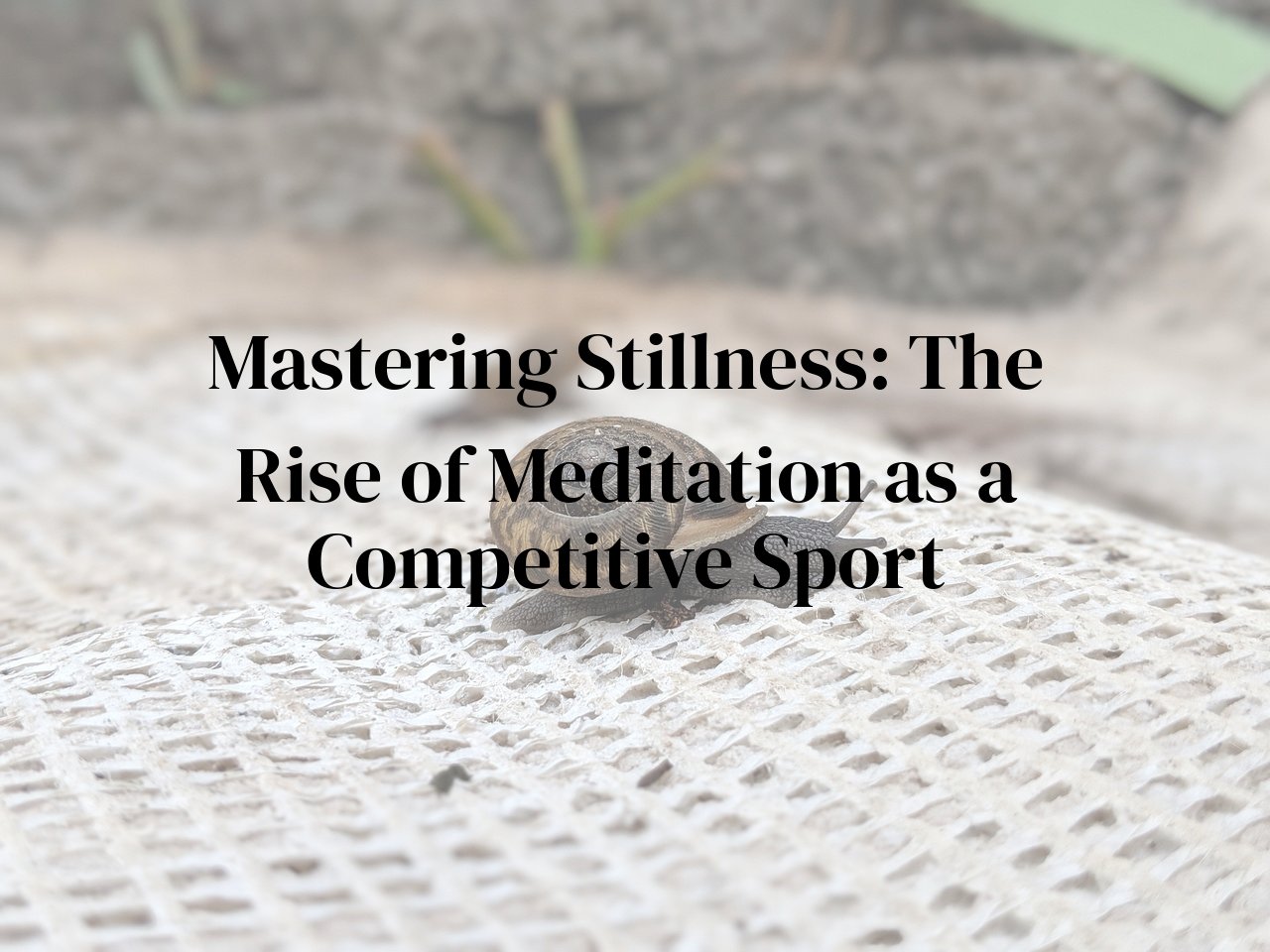
At the intersection of ancient practice and modern competition lies a unique and riveting spectacle: competitive meditation. This blog post offers an intriguing exploration into how a practice traditionally associated with personal tranquility and self-discovery has evolved into a competitive event. Diving deep into the world of competitive meditation, we will uncover the nuances of this new-age tournament, including the captivating blend of mental discipline and sport.
Readers will discover the rules and stakes of competitive meditation events, techniques employed by the contestants, the impact on mental health, and the debate surrounding the commercialization of an age-old spiritual practice. Whether you’re a mindful enthusiast or a curious bystander, this post promises valuable insights into how competitive meditation is changing the landscape of wellness and sport.
Table of Contents
The Foundation of Competitive Meditation: Rules and Objectives
At first glance, the concept of competitive meditation might seem counterintuitive. After all, the practice traditionally promotes peace and self-awareness without the attachment to victory or defeat. However, the foundation of competitive meditation is built upon a set of rules and objectives that aim to standardize and quantify this introspective endeavor, allowing for the rise of meditation as a competitive sport.
The rules are meticulously crafted to ensure fairness and consistency. For example, participants may be required to adopt a specific posture for the duration of the competition, such as the lotus position, and are often given strict guidelines to minimize physical movement. The use of silent timers or mindfulness bells signals the commencement and conclusion of each session, marking the temporal boundaries within which competitors must work.
The objectives in competitive meditation can vary, but they often revolve around the ability to maintain focused concentration or reach a defined state of meditative depth. This is typically measured using physiological indicators like brain wave patterns, heart rate variability, or galvanic skin response. Competitors strive to demonstrate their proficiency through these tangible metrics, balancing the seemingly untouchable aspects of meditation with the concrete demands of athletic competition.
My personal journey into the world of competitive meditation left me both intrigued and perplexed. As I endeavored to silence my mind amidst a room full of equally determined meditators, I learned that the true challenge lay in overcoming the paradox of striving to be the best at a practice that teaches the relinquishing of all desire, including the desire to win. Therein lies the beautiful complexity of competitive meditation: it’s a dance between the serene roots of traditional meditation and the fiery spirit of competition.
Exploring Mental Athletics: Techniques of the Mind
Embarking on a journey through the nuanced terrain of competitive meditation, one discovers a plethora of mental gymnastics—each demanding acute focus, unwavering dedication, and a harmonious synthesis of mind and spirit. As a blogger immersed in the world of meditation, I’ve marveled at the elaborate techniques these mental athletes employ, reminiscent of the meticulous preparations of traditional sports champions, yet unfolding in the silent arenas of inner consciousness.
One such technique is ‘Concentrative Focusing,’ where competitors channel all their attention onto a single point or mantra. Imagine the intensity of a laser beam as it burns through layers of distraction—a metaphor I’ve coined from personal attempts to master this daunting skill. Indeed, during my own forays into competitive stillness, the sheer effort to maintain a pinpoint focus amidst the cacophony of internal noise has been both a torment and triumph of the spirit.
Then there’s ‘Mindful Awareness,’ a technique that challenges competitors to remain utterly present. Here, the flow of thoughts is observed without attachment, likened to leaves drifting on a stream. In my own competition experiences, I’ve come to realize this is not a passive act; it’s a dynamic dance of consciousness, a vigilance that hums with the electric pulse of aliveness.
‘Visualization’ opens yet another dimension, where participants construct intricate mental landscapes, each detail crafted with the precision of a grandmaster architect. Having spent countless hours honing this skill myself, I can attest to the surreal journeys embarked upon, without moving a muscle. Immersing in sensory-rich worlds born of the mind’s eye, competitors strive to achieve a depth of concentration that transcends ordinary reality.
Fusing elements of various traditions, ‘Integrated Mind-Body Practices’ such as Tai Chi and Qigong are also featured, where subtle movements guide energy flow and foster a grounded state of meditation. Though appearing serene on the outside, my endeavors in synchronizing breath with motion have unraveled layers of internal discord, teaching me the profound interconnectedness of the physical and the ethereal.
Lastly, the relentless pursuit of ‘Breath Control’ has swept through competitive circles, entrancing us with its simplicity yet profound impact on mental acuity. The practice of pranayama—ancient breathing techniques—was an epiphany in my own competitive path, revealing how the modulation of breath can sculpt the mind’s landscape, carving out peace from the bedrock of stress.
In this peculiar convergence of stillness and competition, techniques of the mind serve as the arsenal for athletes in the silent sport of meditation. As someone who has dipped toes in these tranquil waters, I’ve learned that the true mastery lies not in the accolades garnered, but in the transcendental journey each competitor undertakes, exploring the vast, uncharted territories within.
The Mental Health Arena: Wellness or Warfare?
The convergence of meditation – hitherto a tranquil pursuit for personal growth and mindfulness – with the competitive zeal of sports raises a compelling question: Does the competitive element enhance wellbeing or does it transform a tool of peace into a battlefield for the mind? While some argue that this fusion can incentivize individuals to make meditation a regular practice, critics warn that the inherent competition may evoke stress and antipathy, potentially undermining the core principles of meditation itself.
In the realm of competitive meditation, participants jostle not for physical dominance but for mental prowess, measuring success through biofeedback metrics such as heart rate variability and brainwave patterns. The irony of this competitive format is that it pitches participants against each other in a domain traditionally dedicated to fostering inner harmony and detachment from the ego-driven rat race.
As I immersed myself in this world, I once found the boundaries between wellness and warfare blurring. During a regional championship, the atmosphere was charged with a curious blend of serenity and silent rivalry. Observing fellow meditators, I sensed a dichotomy; there were those who meditated with blissful expressions, seemingly untouched by the competitive undertones, while others appeared to strain under the pressure to outperform, their brows furrowed in concentration. Was this pursuit of mental excellence superseding the essence of meditation, which advocates for the acceptance of the present moment without judgment?
The term ‘Mental Health Arena’ ostensibly summates this new theatre of meditation. Just as in physical sports, where athletes risk injury in the pursuit of excellence, so too might meditators risk their peace of mind. The competitiveness could foster an environment antithetical to the original intent of meditation – that of nurturing mental health. The question arises: Can the quest to be ‘the best at being present’ genuinely coexist with the philosophy of mindfulness, which teaches that the present moment is already perfect as it is?
An intriguing paradox, the emergence of competitive meditation demands that we rethink our stance on mental health practices. Vying for tranquility seems oxymoronic, yet for some, it has become a catalyst to embrace meditation in a world straying towards relentless competition. As we navigate this curious juxtaposition, we must ask ourselves: Are we promoting mental fortitude or inadvertently turning wellness into warfare?
Mindfulness Meets Monetization: The Debate on Spiritual Commercialization
In the serene expanse where meditation flourishes, the entry of competition and commodification has churned a whirlpool of opinions. The sacred act of inward journeying, quite paradoxically, now finds itself juxtaposed against scoreboards and prize purses. As a practitioner who once sought solace in silent reflection, witnessing this shift is nothing short of bewildering.
The essence of mindfulness, rooted in centuries-old traditions, was to serve as an antidote to the materialistic frenzy. However, my personal encounters with this new competitive sphere have revealed a complex tapestry where spiritual growth is entwined with tangible rewards, sometimes diluting the purity of the practice. Notable are the glossy events where participants are robed not just in humility but in branded meditation gear, surrounded by sponsors’ banners. This, to a grappling mind, can seem a stark deviation from the original intent of meditation.
Scrutiny befalls the sellable meditation ‘packages’ – retreats that promise nirvana yet anchor their allure in luxury over enlightenment. As a blogger, I tread warily here, balancing my enthusiasm for spreading the word of meditation’s benefits with the unease of its market-driven iteration. With entry fees and a spectator base, the once solitary pursuit of inner peace is now a billboard for triumph akin to any other sport.
Yet perhaps the most poignant of all is the narrative that surrounds these events; where once stories of transcendence were shared freely, they are now testimonials heralding a branded methodology. In my interviews with seasoned competitors, there exists a dichotomy between their serene prowess and the bold logos emblazoned upon their attire – a discord between enlightenment and endorsement.
Crucially, in these debates, one must ponder where the line is drawn – when does incentivizing a practice blur into exploiting it? Observing this monetizing momentum, I cannot help but reflect on the irony; that in our collective quest for stillness, we have stirred vast and unpredictable waters, with the perilous potential of washing away the very essence of mindfulness that we seek to uphold.
From Novice to Guru: Personal Experiences in Meditation Competitions
Becoming a competitor in the realm of meditation was a journey I never anticipated taking. My initial foray into this unique sport began with skepticism and curiosity intertwined. As a novice, the very concept of sitting in stillness, competing to achieve a deeper state of calm, seemed paradoxical. Yet, the allure of inner exploration in a competitive format was too intriguing to bypass. I dove headfirst into training, seamlessly integrating techniques of mindfulness with the rigorous discipline of an athlete. It wasn’t about just closing my eyes; it was about sculpting the mind’s focus with the precision of a craftsman.
With each competition, the internal shift from restless novice to centered participant was palpable. The once loud, cacophonous thoughts became whispers, then silent echoes. Under the gaze of judges and the pulse of timed rounds, I learned to harness tranquility as one wields a sword in battle. But this was a peaceful conquest, one where the spoils of victory were moments of profound inner peace and mental clarity.
Gradually, as my expertise grew, so did my reputation. From local events to international stages, my journey threaded through myriad techniques and philosophies, each competition adding layers to my understanding of meditation. The practice deepened, not just as a sport but as a transformative process. I was no longer just a competitor; I was a guide for others, a guru who had forged a path through the unchartered territory of competitive stillness, willing to share the insights of this odyssey.
What began with a curious mind had blossomed into a life enriched by depth and stillness. Personal records and accolades aside, the journey from novice to guru in the meditation competition circuit was a testament to the boundless potential of the human spirit. It was a dance of consciousness, an art of the mind that taught me the true essence of mastery lies not in the pursuit of victory over others, but in the discovery of the tranquility within ourselves.
Conclusion
In conclusion, competitive meditation blurs the lines between serenity and sport, offering a thought-provoking glimpse into the potential of the human mind. Through understanding the rules, techniques, and controversies, we gain insight into not only the competitive sphere but also the broader implications for mental health and modern spirituality. As mindfulness finds its place on the podium, it challenges us to think critically about what it means to truly master the art of stillness.



